|
So its mid January, 2013 and time to work on a project that should have been done at least a couple of years ago. An unrelated decision last month to use the following picture taken at Rockport/Cape Ann, Massachusettes 3 years ago, as my desktop screen background, was a daily reminder. These are Marionette's lifelines.
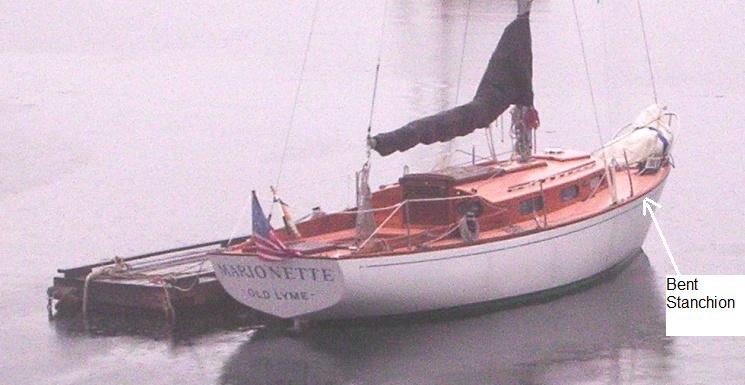
The basic lifelines have 3 stainless steel stanchions on each side. The aft terminal jaw shackles to a padeye inside the toe rail on deck at the transom; the forward end has a turnbuckle and its open jaw fastens to a padeye on top of the toe rail forward of the bow pulpit rail. There is no stern pulpit/pushpit but If you look carefully you will see a lifeline rigged from the top of the aft stanchion to a ring on the backstay. This gets rigged when weather conditions warrant, or when single handing. These close up pictures should help.

Forward end of lifeline

Aft end of lifeline
|
|
Forward padeye |
Aft padeye |
The lifelines reeve through a fitting that fits into the top of an 18" long, 3/4" OD stainless steel tube, which fits into a deck fitting. The tube is held in place by a set screw just visible lower right. The top fitting is held in place by the down pressure of the 'taut' lifeline. More on this later.
|
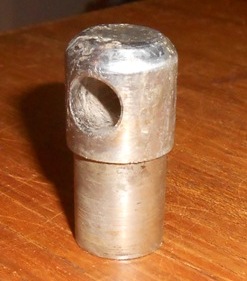 |
|
The assembly |
The tube fitting |
The deck fitting |
Marionette's crew is well aware that reverse gear is not available. So when the ship is slowly, and occasionally, not so slowly, gliding into her slip, crew have been known to leap on the dock and attempt to slow down her 5000lbs before the unthinkable happens. Admiring and helpful, sometimes wide eyed, bystanders on the dock have also offered assistance. The closest stanchion is the nearest handhold and over the years has suffered. A picture is worth a thousand words
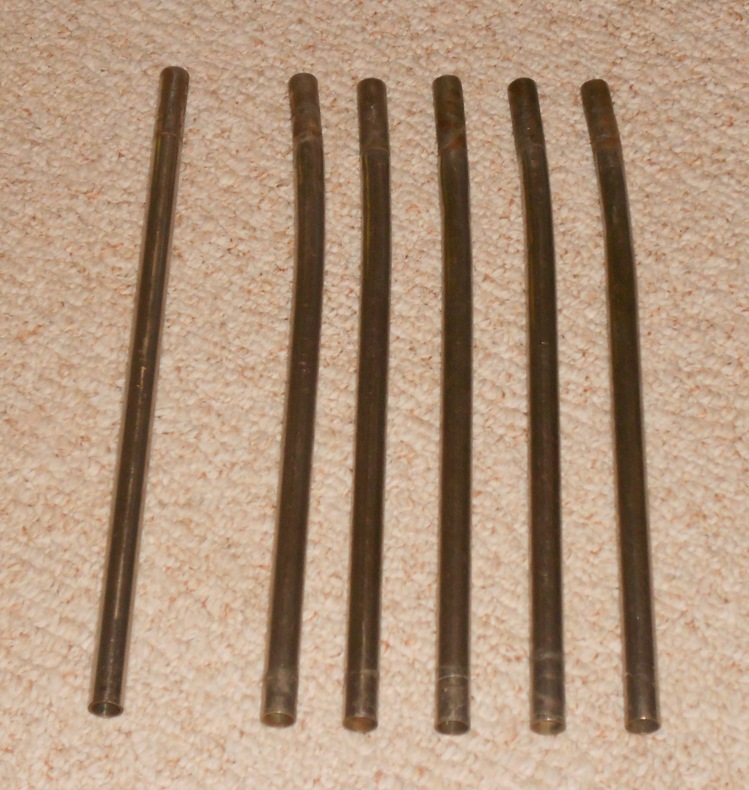
The wall thickness of the 'five' is .049"; the "one" is .065"
These same stanchions, rotated annually to spread around the previous year's bending, have been on Marionette since I got her 18 years ago. Sometime in her past that "one" got replaced with a thicker wall tube and it seems to have fared very nicely.
Last year while racing one of Marionette's crew 'lurched' while holding on to the lifeline near one of the stanchions and pulled the 'taut" lifeline fitting out of the tube - a first! The fitting was eventually pushed back into the tube, and the lifeline eventually 'tauted". But the memory lingered...
So, with the background set, and winter upon us, a project plan was put into motion.
Initially the Plan was to replace the 'five' .049" wall thickness tubes with .065 wall thickness tubes - proven to stand the bending test of time, and consider ways to afix the top fitting so it can't come out. This turned out to have unsatisfactory solutions - not enough material for a set screw to lock it in; a through bolt would have a head/nut that could/would hang up a sheet, or your clothes, or your skin, or....
The old salt, rigger/ machinist, Dave, who built the sling poppits for our 'No Travel Lift" system (http://www.dolphin24.org/no_travel_lift.html) plus over the past 18 years made/modified numerous other Dolphin fittings and parts, (ie a rudder post heel fitting for Passage) in his shop, suggested "why not solid posts with a hole through the top end?" After the shock of contemplating all that additional weight wore off, that's what we decided to do.
February 8, 2013. "Historic Blizzard Nemo/Charlotte" was raging in the US Northeast threatening project timing - but I managed to pick up my new stanchions at Dave's shop before travel became too hazardous. A report on Charlotte/Nemo can be seen by clicking here
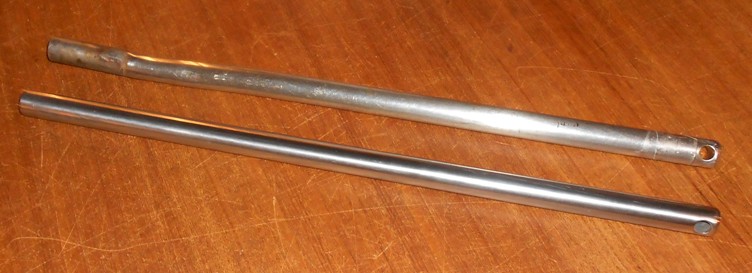
New solid post at bottom, old .049 wall tube post with fitting above
|
The new posts are 3/4" OD, #304 stainless solid bar. They weigh 2.3 lbs each vs .6 lbs for the old .065 wall thickness tube and fitting. The raw material cost was $13 ea for the solid bar vs $11 ea for the tubes. The cost to machine the lifeline holes, bevel the top edge, and the lifeline holes, and polish was $150. Total cost, $228, $38 per stanchion. Total system weight increase 10.2 lbs over a .065 tube, 11.1 lbs over .049 tubes....
THEY WON'T BEND, AND THE FITTING CANNOT PULL OUT - AND IF WE LOSE A RACE BY LESS THAN 5 SECONDS WE CAN BLAME IT ON THE ADDITIONAL WEIGHT, NOT NAVIGATIONAL OR TACTICAL ERROR!!
Of course, there is that old failure mode analysis principle to consider - what is the next weakest point in the system - could it be that the weaker tubes protected the stanchion base deck fittings? Stay tuned...
|
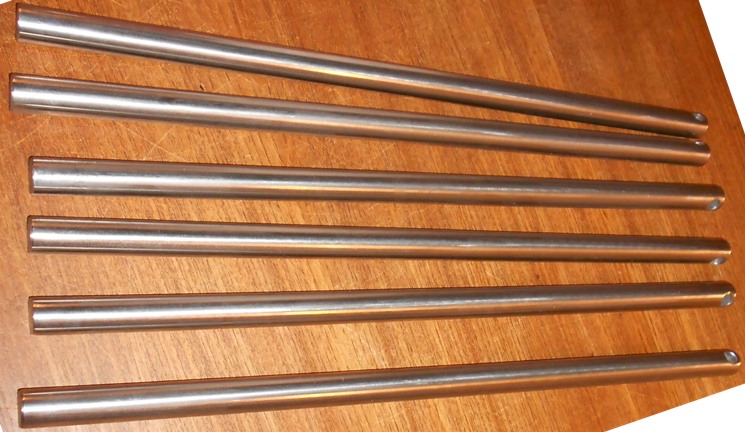
Beautiful - and in place no one will know....
This Spring we'll post an in-place picture here
**********************************
One more thing - the lifelines themselves had a few gouges and small cracks in the cover. After re-checking and verifying my claim that the wire was in good condition, my old salt rigger Dave told me to lightly rough up, then paint, the affected areas with a couple of light coats of white Marine Tex. Below is the before and after. We'll report how it fares after a season's use.
|
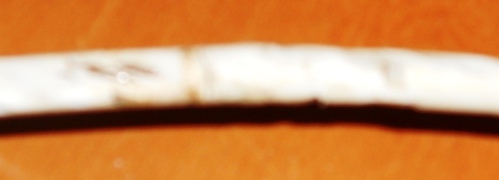
Before

After
|
***********************************
November 18, 2014. Mike Friel is planning on installing new lifelines and stanchions on Makarios, Yankee #241 and the question came up about pole angle. Here's his email
Hey Ron,
On my search for stanchions for my Dolphin I'm not sure if I want to get bases that angle the stanchion pole inwards or that keep it straight up. I've looked over as many photos in the Roster section as I could to try and get an idea of what is being used. I've placed a carpenter's square on deck to get an idea of what a right angle or straight pole option would look like. This seems to look OK. I don't think there is that much deck camber that I would need a 3-5* angled base that seems to be readily available.
I've scrutinized what you did with Marionette's stanchion poles trying to get an idea if your bases are straight or angled. Can't tell for sure. Do you remember? It seems that in one pic there was an angled pad under the base. Am I seeing things?
Thanks for any help,
Mike
Here's my reply
|
Hi Mike
Yes, Marionette has thin tapered wood pads beneath the flat stanchion bases.
Here's a picture of the port quarter area and you can make out the taper. I have a wood deck so I'm not sure the deck cambers are identical on our boats.
That's a 'before' new solid stanchions pic so the post looks a little bent, to my eye.
Ron
Click on the picture for a larger image
ps Mike has finally got some stanchions - click here to go there |
********************************************
|
